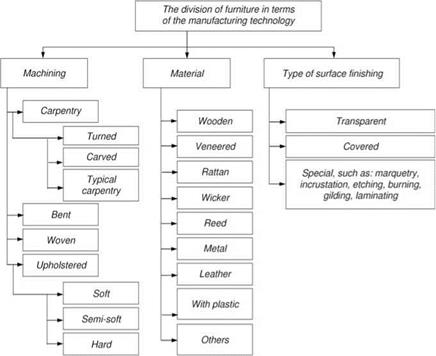By creating a division of furniture according to the technological characteristics, one should keep in mind both the variety of used machining processes and the types of materials used, as well as methods of finishing visible surfaces.
Technologies of manufacturing furniture can be brought together into four main groups: machine cutting, machine bending, weaving, and the technology of cutting and sewing cover materials. In terms of these technologies, furniture is divided into the following groups (Fig. 2.15):
• carpentry,
• bent,
• woven and
• upholstered.
Carpentry furniture is made of wood or wood-based materials by way of the classical machine cutting. These include the following:
• turned furniture,
• carved furniture and
• typical carpentry furniture.
Bent furniture is commonly manufactured using the hydrothermal treatment and wood bending or by bending together with simultaneous bonding of thin veneers of wood and wood-based materials. The modern technology of manufacturing
|
Fig. 2.15 The division of furniture in terms of the manufacturing technology |
components for bent furniture production was proposed by the Danish company Compwood Machines Ltd. (www. compwood. dk). This technology consists in softening the wood point by steaming in autoclaves or heating in a high-frequency electric field and then compressing the wood in one axis along the fibres to up to about 80 % of the initial length of the element. After such a process, the element is suitable for free bending or bending using tapes and bending limiters.
Woven furniture is formed primarily by using thin and flexible materials, which can be used to shape full or openwork surfaces of seats, backs and sides of chairs, armchairs and sofas. They also constitute the decorative element of door panels or sides of bodies of case furniture. Usually, for weaving, wicker, rattan, peddig, bamboo, water hyacinth, raffia and loom are used.
Upholstered furniture has a complex construction and various ways of making the elastic section and upholstered section. They are usually formed by stretching over and fitting of a cut and sewn cover on a frame with an elastic layer. In terms of the measurable criterion of the softness of the mattress or seat, upholstered furniture can be divided into:
• soft,
• semi-soft and
• hard.
This division is quite subjective and in many cases depends on the individual feeling of softness of the seat by the designer or manufacturer. In order to objectify and quantify this division, a value of acceptable pressure on the human body in contact with the mattress should be assumed as the criterion of evaluating softness. Krutul’s studies (2004a, b) show that the acceptable level of pressure on the human body, not hampering blood circulation in arteries, veins and capillaries, should not be higher than 32 mmHg = 4.26 kPa. On the basis of the results of the works carried out by Smardzewski et al. (2007, 2008), it was also shown that the value of contact pressure depends on the construction of the mattress and the kind of elastic materials used. The lowest pressure on the human body, with a value of up to 28 mmHg = 3.73 kPa, is obtained on water mattresses. For foam and hybrid systems of foam-spring sets, the value of pressure ranges from 45 to 120 mmHg (from 5.99 to 15.99 kPa). Taking this into consideration, the following numeric indexes can be suggested for the previously proposed division of furniture:
• soft, acceptable pressure on the human body no greater than 5 kPa,
• semi-soft, acceptable pressure on the human body ranging from 5.1 to 9 kPa and
• hard, acceptable pressure on the human body greater than 9.1 kPa.
Due to the type of material used, we divide furniture into:
• wooden, in which at least the basic construction consists of elements made of wood or wood-based materials,
• veneered, in which surfaces are veneered with a thin layer of precious wood— veneer, thin films or decorative papers,
• rattan, in which the basic bearing construction of the furniture piece consists of elements made of rattan bars (rotang) usually with a diameter of 35 mm,
• wicker, in which the entire construction or only the woven back or seat is made of wicker,
• reed, in which the entire construction or only the woven back or seat is made of reed,
• metal, in which the construction is made of metal, while wooden or wooden-based elements are only a supplement,
• with plastic, in which the construction is made of plastic,
• leather, usually upholstered furniture, which has all external surfaces or only use surfaces covered with natural leather and
• others.
Taking into account the method offinishing the surface of a ready product, furniture can be divided into:
• transparent, with a visible structure and drawing of the base,
• covered, with an invisible structure and drawing of the base and
• special, such as marquetry, incrustation, etching, burning, gilding and laminating.




